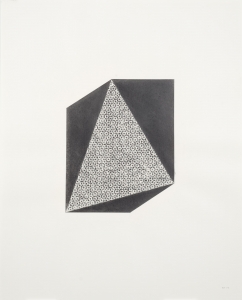TIEMANN: POSITIVE MINIMALISM
by Helena Dalrymple in Voices of Art, Vol.7, No.2 April/May 1999
I encountered Robert Tiemann twice in the week of March 1, 1999. Both were positive and enriching experiences. First was at ArtPace, where Tiemann was a participant in a panel discussion: “Critical Voices, Readers Voices,” coordinated and moderated by Frances Colpitt. There the issue of the state of art criticism in San Antonio was discussed from a reader’s point of view. This article is not about that panel discussion, so I will not recap that soiree here, but to say that Tiemann was the sole voice of reason. He was down-to-earth, wise and humble both as an artist and a reader, I liked him immediately and was disappointed that I could not stay after the panel broke up to introduce myself.
My opportunity to do so was not far off. I got my chance to meet Tiemann personally a couple of days later when I attended the opening of his art exhibit at the Joan Grona Gallery. Meeting this artist was not the only positive thing to happen to me that evening. I also introduced myself to his art. I must admit, I am not one who cares for minimalism, but I went to Joan Grona’s gallery wanting to see Tiemann’s work, because I like him. This is what got me past that first internal groan as I approached the clear glass door and got my first peek at his work. I am glad I took a second, closer look.
Tiemann’s work fits the description of minimalism to a T. It is non-objective, with repetitious imagery and a limited palette. From a distance, it looks like everything else out there that fits the genre: blurry, unfocused monochromes that don’t challenge the viewer or communicate the artist’s point of view. But on closer inspection, Tiemann incorporates depth, illusion and subtlety in his work that skillfully overcomes the obstacles which make minimalism cold, distant and both emotionally and visually flat.
The way Tiemann obliterates the usual “flatness” of minimal work is what I find most engaging. He has chosen to paint on pegboard, an everyday material we all have had or do have in our garages. By using a surface each of us has encountered in our personal lives, Tiemann gives us something to which we can relate and connect to on an emotional level. For me, it summoned a memory of visiting my father in his garage workshop, wanting to help him with his projects. Tiemann’s treatment of this surface is what gives his work visual depth as well. He fills most of the holes with gesso, then smears irregular stripes of black paint over them, giving the surface the appearance of being warped, yet this is just a clever illusion, created by the way Tiemann has applied the paint in varying thicknesses. Tiemann ingratiates his work with subtle additions of color. He has added a swatch of green in the lower corner of one piece and several rows of blue dots among thousands of black and white ones in another. Distance is minimized by his subtle invitation to come closer—those same blue dots can only be seen at a distance of a foot or less.
I still have not been won over by minimalism, but Tiemann makes a good argument, His work is mature, well-crafted and engaging. It is certainly better than most of the work in the genre.
During my encounters with Robert Tiemann, both in his comments and the “Critical Voices” panel and in our more personal discussion of the same topic at his opening at the gallery, he emphatically stated that he no longer reads art magazines, because, he says, “they are just ads for artists,” adding, “I haven’t seen an artist trashed in an art magazine in a long time.” His point that art “criticism” is rarely negative is well taken, and I know he is probably disappointed that I didn’t trash his work here. Forgive me, Bob. I like your stuff.

